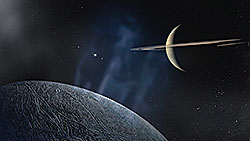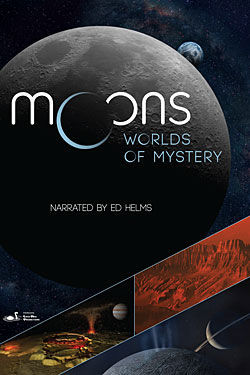Moons: Worlds Of Mystery
Take a fascinating trip to the little worlds of our solar system!
When you consider the solar system, you often think of the Sun and its planets. But what about moons? What role do they play? Find out in Moons: Worlds of Mystery, a show from the Charles Hayden Planetarium of the Museum of Science, Boston. It explores the many and varied satellites that exist, delves into what they look like and what they contribute to our knowledge of the solar system — a hundred known satellites throughout the solar system, orbiting five other planets and even some asteroids and Kuiper Belt objects.
 Moons: Worlds of Mystery show starts with our own Moon, and explores its birth in a violent collision between infant Earth and a Mars-sized object some 4.5 billion years ago. The Moon has contributed not only to Earth's stability, but possibly even to the conditions making our planet habitable for early life. Today we explore the Moon remotely, with landers and orbiters. But, one day soon, people will return to the Moon to live and work.
Moons: Worlds of Mystery show starts with our own Moon, and explores its birth in a violent collision between infant Earth and a Mars-sized object some 4.5 billion years ago. The Moon has contributed not only to Earth's stability, but possibly even to the conditions making our planet habitable for early life. Today we explore the Moon remotely, with landers and orbiters. But, one day soon, people will return to the Moon to live and work.
 The show turns next to the incredible diversity of moons around Jupiter, including the four discovered by Galileo Galilei and recently explored by sophisticated modern spacecraft. They run the gamut from Io's volcanic inferno to Europa's icy subsurface oceans.
The show turns next to the incredible diversity of moons around Jupiter, including the four discovered by Galileo Galilei and recently explored by sophisticated modern spacecraft. They run the gamut from Io's volcanic inferno to Europa's icy subsurface oceans.
 We learn by looking at moons around Saturn that their gravity and interactions govern phenomena such as tidal force and planetary ring structure. Perhaps most intriguing is the exploration of moons that could support extraterrestrial life.
We learn by looking at moons around Saturn that their gravity and interactions govern phenomena such as tidal force and planetary ring structure. Perhaps most intriguing is the exploration of moons that could support extraterrestrial life.
 Moons: Worlds of Mystery then explores Titan's liquid oceans of ethane and methane, and encourages us to reevaluate just what conditions are suitable for life.
Moons: Worlds of Mystery then explores Titan's liquid oceans of ethane and methane, and encourages us to reevaluate just what conditions are suitable for life.
Finally, our exploration brings us to the outer solar system, with the discovery of moons orbiting asteroids and Kuiper Belt objects like Pluto. They show the incredible diversity of worlds, both large and small, that orbit the Sun. With these revelations, we will piece together the long history of our Sun, planets, and moons. It's exciting to wonder where humanity's curiosity and imagination will take us next!

Running time: 35 minutes (24 minute version available)
Suitable for: General Public
Information about: Solar system, the Moon, moons around other worlds
Year of production: 2013
None yet!
Don't see the language you want? Let's work together with the producer to create it. Read more here!
Educators — looking classroom activities and educational standards descriptions for this show? Download the Museum of Science's useful Educator's Guide.



